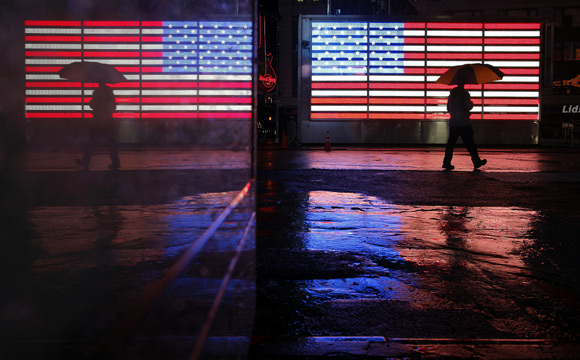
How does a devastating megastorm, which has been wreaking unimaginable havoc in mighty New York City and other places in the United States, get an innocuous and sweet name like Sandy?
Tropical storms are often given names to make communication easier between authorities, weather officers and the general public.
It is far easier to remember an everyday name like Sandy or Isaac, rather than technical names to indicate the storm's intensity or direction. Confusion about multiple storms in the same area or in the same year can be avoided by giving them names that are distinctive yet not too cumbersome.
Click on NEXT for more...

Incidentally, contrary to popular perception, hurricanes are not named at all. When tropical storms cross the speed of 39 mph, they are given a name. When the storm crosses 74 mph, it turns into a hurricane but retains the same name.
According to folklore, the trend of naming cyclones was started by an Australian forecaster, who named the natural disasters after political leaders whom he greatly disliked.
During World War II, homesick personnel of the US Army and Navy started naming cyclones after their girlfriends or wives back home, presumably because they missed their partners while out on the battlefield.
Click on NEXT for more...

Although it is amusing to note that the military men chose to associate their girlfriends' or wives' names to sentences that ended with 'left a wake of destruction' or 'battered the coast, killed many'.
The first official list of typhoons was taken up in 1945.
In 1953, the US weather bureau officially put up a list of cyclones that had only women's names. The list was modified to include men's names as well in 1979, probably after the bureau received considerable flak from feminist groups.
In 2000, the list of cyclone names was made more diverse by adding Asian names as well as the names of animals, birds, trees and flowers.
Click on NEXT for more...

While weather bureaus from across the world are allowed to contribute names to the list of cyclones, the final list is decided by the World Meteorological Organisation, with special inputs from those nations which are more severely affected by the storm.
In case of storms that turn out to be especially severe – like Cyclone Nargis or Hurricane Katrina – the names are either not reused for at least ten years or 'retired' permanently as a mark of respect towards the victims.
Storms are also named after Greek alphabets like Alpha, Beta, Gamma in the rare situation when a weather bureau runs out of names for cyclones.
Click on NEXT for more...

But that is an extremely unlikely scenario as the World Meteorological Organisation has six lengthy lists of cyclone names, classified on the basis of the region they originate from, and these lists are used every six years.
As per the list of tropical cyclone names in the northern hemisphere, the storm that will succeed megastorm Sandy will be called Tony.
And back here in India, even if Cyclone Nilam somehow manages to skip Tamil Nadu and Andhra Pradesh, we need to be ready for Cyclone Mahasen, which will be the next storm that will head our way.
Click on NEXT for more...
...